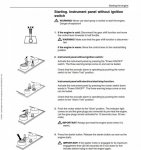nigelmercier
RIP
- Joined
- 20 Jun 2007
- Messages
- 16,234
- Location
- Live in Kent, boat in Canary Islands
The more I look at the diagram below the more I think it's weird.
Why the diode across the transistor, the 3 round the horn (is it 9V or something) and between the Water & Charge lamps? Even the horn test is not valid, as the current takes an entirely different path.

This is my (revised) version of my MD22P-B alarm unit in situ, taken from various sources:

I'm thinking of building a box that takes inputs from the alarm panel, processes them with a microcontroller, and sounds different alarms for the different faults. I plan to use a 100dB+ alarm unit, as I can't always hear the existing one at around 85dB (SC 235 BF made by Sonitron: http://view.ceros.com/sonitron/catalogue/p/12)
My diagram above shows the 5 wires that go from the encapsulated alarm unit to an "Extra Display" via an AMP Universal MATE-N-LOK 350810-1 connector, this mates with an AMP 350809-1.
Does anyone know where these 5 wires are connected internally to the alarm unit?
Last edited:


